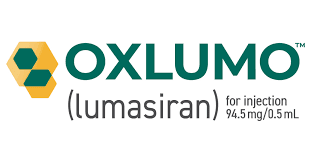OXLUMO (lumasiran) injection, for subcutaneous use
Lumasiran is a HAO1-directed double-stranded small interfering ribonucleic acid (siRNA), covalently linked to a ligand containing N-acetylgalactosamine (GalNAc).
Lumasiran reduces levels of glycolate oxidase (GO) enzyme by targeting the hydroxy acid oxidase 1 (HAO1) messenger ribonucleic acid (mRNA) in hepatocytes through RNA interference. Decreased GO enzyme levels reduce the amount of available glyoxylate, a substrate for oxalate production. As the GO enzyme is upstream of the deficient alanine:glyoxylate aminotransferase (AGT) enzyme that causes PH1, the mechanism of action of lumasiran is independent of the underlying AGXT gene mutation.
Initial U.S. Approval: 2020
Lumasiran is a HAO1-directed double-stranded small interfering ribonucleic acid (siRNA), covalently linked to a ligand containing N-acetylgalactosamine (GalNAc).
Lumasiran reduces levels of glycolate oxidase (GO) enzyme by targeting the hydroxy acid oxidase 1 (HAO1) messenger ribonucleic acid (mRNA) in hepatocytes through RNA interference. Decreased GO enzyme levels reduce the amount of available glyoxylate, a substrate for oxalate production. As the GO enzyme is upstream of the deficient alanine:glyoxylate aminotransferase (AGT) enzyme that causes PH1, the mechanism of action of lumasiran is independent of the underlying AGXT gene mutation.
Initial U.S. Approval: 2020
INDICATIONS AND USAGE
OXLUMO is a HAO1-directed small interfering ribonucleic acid (siRNA) indicated for the treatment of primary hyperoxaluria type 1 (PH1) to lower urinary oxalate levels in pediatric and adult patients.
DOSAGE AND ADMINISTRATION
The recommended dose of OXLUMO by subcutaneous injection is based on body weight.
Body Weight Loading Dose Maintenance Dose (begin 1 month after the last loading dose) less than 10 kg 6 mg/kg once monthly for 3 doses 3 mg/kg once monthly 10 kg to less than 20 kg 6 mg/kg once monthly for 3 doses 6 mg/kg once every 3 months (quarterly) 20 kg and above 3 mg/kg once monthly for 3 doses 3 mg/kg once every 3 months (quarterly) See Full Prescribing Information for important preparation and administration instructions.
DOSAGE FORMS AND STRENGTHS
DOSAGE FORMS AND STRENGTHS
Injection: 94.5 mg/0.5 mL in a single-dose vial.
CONTRAINDICATIONS
None.
ADVERSE REACTIONS
The most common adverse reaction (reported in ≥20% of patients) is injection site reactions.

Comments
Post a Comment